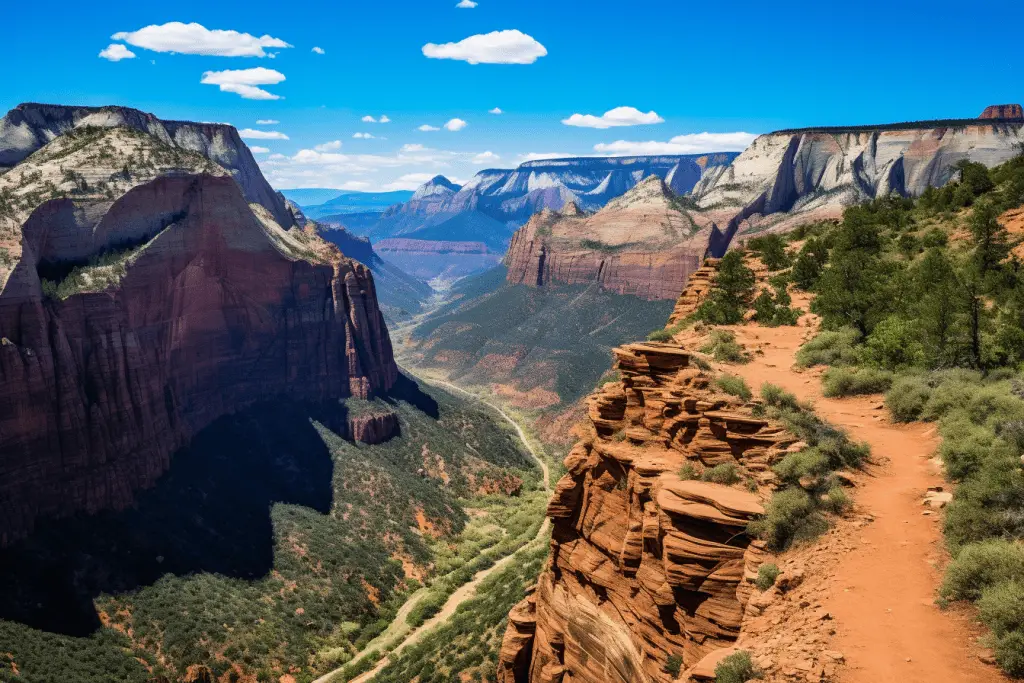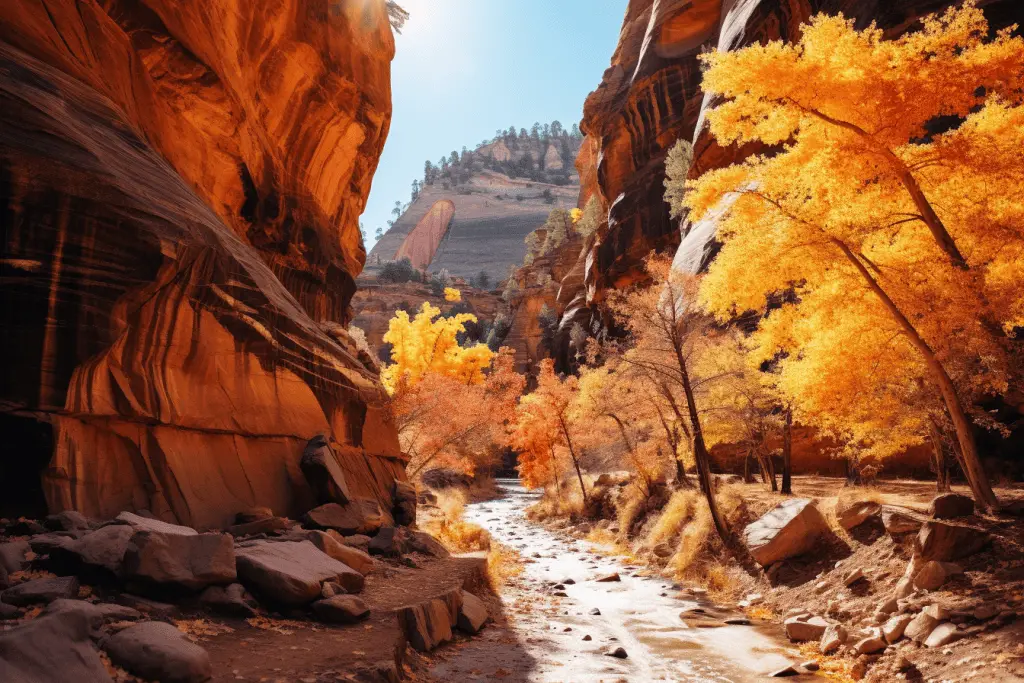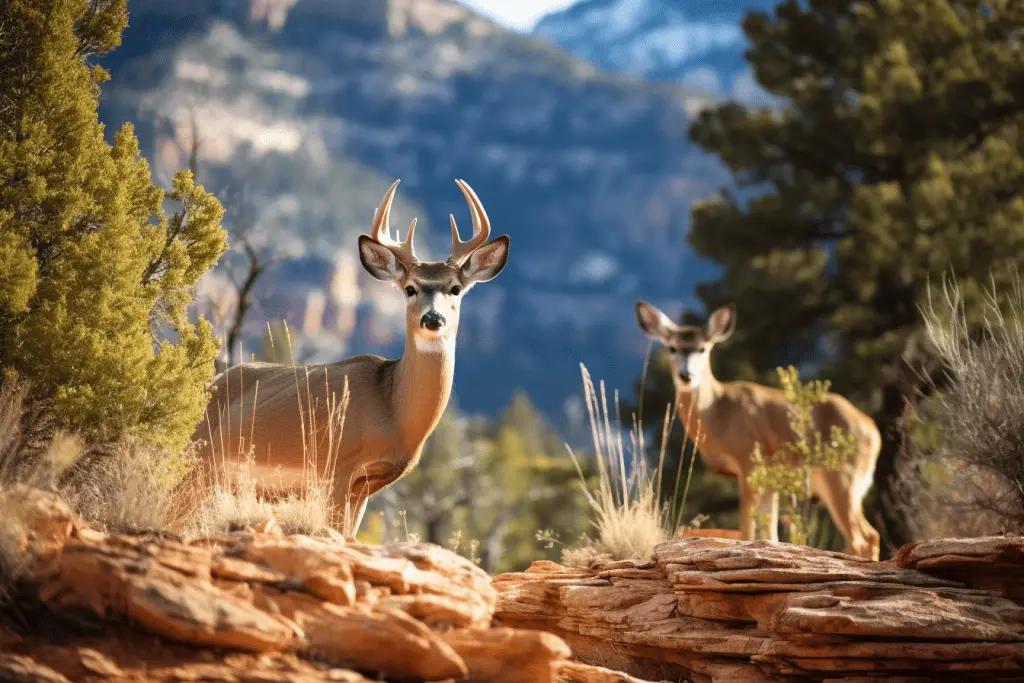Observation Point is one of the most scenic overlooks in Zion National Park, providing an incredible view of Zion Canyon below. If you’re considering making the trek, there are some things you should know before hiking Observation Point.

About The Trail: Length, Elevation, Difficulty
Observation Point isn’t just any hiking trail; it’s a rite of passage for nature enthusiasts. Stretching out over a distance of roughly 8 miles (round trip), this trail offers a robust experience for those seeking both adventure and mesmerizing views. As you lace up your boots, you’ll be preparing to ascend an elevation gain of about 2,150 feet. Yes, it’s quite the climb, but the panoramic vistas from the top are worth every bead of sweat!
However, the beauty of the trail doesn’t mean it’s a walk in the park. Ranked as a moderate to strenuous hike, Observation Point demands a good level of physical fitness. The path, while well-trodden, has its steep stretches and zigzagging switchbacks. So, while it’s not the Everest of hikes, it’s not a casual Sunday stroll either.
If you’re a newbie, don’t be too intimidated. Many first-timers have tackled Observation Point and returned with stories of exhilaration (and, okay, a bit of muscle soreness). Just make sure to pace yourself, take breaks when needed, and always stay hydrated.
The trail offers various points of interest, from the unique rock formations to the occasional wildlife sightings. It’s these elements, combined with the physical challenge, that make this hike a must-do. Whether you’re a seasoned hiker looking for a new challenge or a beginner wanting to test your limits, Observation Point promises an unforgettable experience.
| Trail Feature | Details |
|---|---|
| Length | 8 miles (round trip) |
| Elevation Gain | 2,150 feet |
| Difficulty | Moderate to Strenuous |
Trail Highlights
One of the reasons the Observation Point trail is so revered by hikers is its sheer array of scenic highlights. Right from the start, you’re treated to the winding beauty of Echo Canyon, with its intricate rock walls and unique slot canyons. As you weave through the path, you’ll be mesmerized by the vast expanses of Zion National Park sprawling beneath you. It’s like watching nature’s own IMAX movie, but better because you’re part of the scene.
Then, there’s the grandeur of White Cliffs. These ancient formations stand as tall, silent witnesses to eons gone by, their whitish hue contrasting beautifully against the deep blue sky. As you approach the top, the trail unveils its pièce de résistance: a sweeping, panoramic view of the Zion Canyon, Angel’s Landing, and the meandering Virgin River. It’s a sight that has left countless hikers momentarily speechless.
The joy of this trail doesn’t rest solely on its endpoints. The journey itself is filled with smaller wonders – from the occasional sighting of Zion’s diverse wildlife to the dance of sunlight and shadow on the red rock walls. Each turn, each ascent, and each plateau presents a new vista, a fresh perspective, ensuring that the trail remains as engaging at the end as it was at the start.
| Trail Highlights | Brief Description |
|---|---|
| Echo Canyon | Intricate rock walls and stunning slot canyons. |
| White Cliffs | Majestic ancient rock formations with a unique white hue. |
| Panoramic Views | Overlooking Zion Canyon, Angel’s Landing, and the Virgin River. |
| Wildlife Sightings | Chance encounters with Zion’s diverse fauna amidst the natural beauty of the trail. |
Best Time To Hike Observation Point
If you’re aiming for the optimal Observation Point experience, timing is key. Zion National Park, where this gorgeous trail resides, is renowned for its seasonal splendors and occasional extremes. Spring, particularly from April to May, emerges as a top contender. The weather during these months is comfortably cool, flowers begin to bloom, and water sources are generally abundant from melted snow.
Then comes fall, another prime time to hike, especially between late September and early November. The scorching summer heat mellows out, replaced by crisp air and a kaleidoscope of autumn colors. The park is painted in golden yellows, fiery reds, and rich oranges, making every step of your hike a visually delightful affair.

However, summer and winter are more of a mixed bag. Summers, especially from June to August, can get sweltering, and the trail becomes challenging under the beating sun. On the other hand, winter, while offering snow-capped views, poses risks with icy trails and shorter daylight hours. But, if you’re adequately prepared and up for the challenge, these seasons still have their unique charm.
Another factor to consider is crowd density. Zion is popular, and summer months often mean packed trails. If you’re craving solitude, aim for the shoulder seasons or set out early in the morning, regardless of the season.
Here’s a brief overview of what each season offers:
| Season | Weather | Crowd Level | Trail Condition |
|---|---|---|---|
| Spring | Cool and refreshing | Moderate | Generally clear with blooming flowers |
| Summer | Hot and dry | High | Dry and potentially scorching |
| Fall | Crisp with fall foliage | Moderate-High | Clear trails with colorful scenery |
| Winter | Cold with potential snow | Low | Icy patches and shorter daylight hours |
How To Get To Observation Point’s Trailhead
Navigating your way to the trailhead of Observation Point can be part of the fun, especially if you’re a first-timer in Zion National Park. The trailhead is conveniently located at the Weeping Rock parking lot. If you’ve got a personal vehicle, you can drive right up to the park’s entrance, but during the busy months (typically April through October), Zion restricts private vehicle access deeper into the canyon.
During these busier times, the park operates a super-efficient shuttle system that takes visitors to various trailheads, including the one for Observation Point. You’d hop onto the shuttle at the Zion Canyon Visitor Center. The Weeping Rock stop, which is shuttle stop number 7, is your destination. Don’t worry about missing it; drivers usually announce each stop, and there are often fellow hikers bound for the same trail.
Follow this link to see the Zion Canyon Shuttle System Schedule.
Now, for those eager beavers who want an early start before the shuttles begin operating, or those who simply love a longer trek, there’s an alternative. You can hike the East Mesa Trail, which also leads to Observation Point, and this trailhead can be accessed by a different route, one that allows personal vehicles.
Winter months or off-peak times do relax the shuttle-only restriction. If you’re visiting during these quieter periods, you can drive directly to the Weeping Rock parking lot. Just a heads-up, though parking spaces are limited, so an early start might guarantee you a spot.
| Method | Starting Point | Notes |
|---|---|---|
| Shuttle Bus | Zion Canyon Visitor Center | Stops at Weeping Rock (Stop #7) during peak months. |
| Personal Vehicle (Peak) | East Mesa Trailhead | Alternative route to Observation Point; bypasses shuttle restrictions. |
| Personal Vehicle (Off-peak) | Weeping Rock Parking Lot | Direct access during quieter months; limited parking. |
Remember, whether you’re on a shuttle or in your own car, the journey to the trailhead is filled with scenic delights. So, sit back, enjoy the views, and gear up for the hike ahead!
Preparing To Hike Observation Point: What To Bring
Hiking Observation Point is a thrilling adventure, but being well-prepared is essential. Here’s a list of things to bring:
- Backpack: A comfortable daypack to carry your essentials.
- Water: At least 2-3 liters per person; hydration is crucial. Consider a hydration bladder for easy sipping while walking.
- Snacks: Energy bars, trail mix, dried fruits, and nuts to keep your energy up.
- Sturdy Footwear: Hiking boots or trail shoes with good ankle support and grip.
- Weather-appropriate clothing:
- Lightweight, moisture-wicking clothing for warmer months.
- Layered clothing for cooler months, including a warm hat and gloves.
- A rain jacket or poncho, just in case.
- Sun Protection:
- Sunscreen with high SPF.
- Sunglasses with UV protection.
- Wide-brimmed hat or cap.
- Navigation Tools:
- Trail map and compass.
- GPS or a hiking app on your phone.
- First-Aid Kit: Including band-aids, antiseptic wipes, blister treatment, pain relievers, and any personal medications.
- Emergency Whistle: Useful for signaling in case of emergencies.
- Multi-tool or Knife: Handy for a variety of situations.
- Flashlight or Headlamp: With extra batteries, especially if you start early or finish late.
- Trekking Poles: Especially helpful for the uphill and downhill sections.
- Camera or Smartphone: For capturing the breathtaking views.
- Personal Identification & Permits: Some trails require permits, and it’s always good to have some form of ID.
- Toilet Paper & Sanitation Trowel: There aren’t any facilities on the trail, so be prepared to follow Leave No Trace principles.
- Bug Spray: Especially useful during certain times of the year.
- Lightweight Emergency Shelter or Space Blanket: In case of unexpected weather changes or emergencies.
- Extra Plastic Bags or Ziplocs: Useful for packing out trash or keeping gear dry.
- Backup Water Treatment: Such as water purification tablets or a small filter, in case you run out of water and need to refill from natural sources.
- Notebook and Pen: For jotting down notes or thoughts.
Remember, it’s always better to be over-prepared than under-prepared. Before embarking on your hike, double-check your gear, understand the weather forecast, and ensure you’ve informed someone of your hiking plans.
Wildlife To Expect When Hiking Observation Point
When you lace up your boots for Observation Point, it’s not just the scenic vistas that’ll captivate you. Zion National Park, home to the trail, is a bustling hub of wildlife, and each twist and turn might introduce you to one of its residents.
First up, bird enthusiasts, keep your binoculars ready! You might spot the Peregrine Falcon soaring high or hear the unique song of the Canyon Wren. The steep cliffs and canyons are also home to the California Condor, one of the world’s largest birds, making a triumphant return from the brink of extinction.
As you meander along the trail, you might notice some critters scurrying around. These could be anything from the harmless Utah Prairie Dog to Rock Squirrels. Remember to give them space; while they’re used to seeing hikers, they’re still wild animals. And oh, keep an eye out for mule deer gracefully making their way through the park’s varied terrains.

Reptile lovers, there’s something for you too. While the park is home to several lizard species, the one you might most commonly spot is the Plateau Lizard basking on sunlit rocks. Just remember, while snakes are relatively rare, they do exist in Zion, including the potentially dangerous rattlesnake. Always be aware of where you step and give snakes a wide berth.
Lastly, though they’re elusive and a rare sight, mountain lions do call Zion home. Chances of an encounter are minimal, but it’s always wise to be informed and prepared. Remember, the wildlife is a big part of what makes Observation Point such a magical hike. Respect their space, and enjoy the added bonus of witnessing nature in all its glory.
Tips for Staying Safe While Hiking Observation Point
Hiking in Zion’s breathtaking landscapes is an experience unlike any other, but safety should always be your number one priority. Here are some tips to ensure your hike is as safe as it is memorable:
- Stay on Designated Trails: The marked paths are there for a reason. Venturing off can be hazardous due to unstable grounds, and it can also harm delicate vegetation.
- Know the Signs of Heat Exhaustion: Symptoms include heavy sweating, weakness, dizziness, nausea, headache, and muscle cramps. If you experience these, rest in a shaded area, sip water slowly, and consider turning back.
- Avoid Cliff Edges: They may appear solid, but rock and soil near the edge can be loose and crumbly. For those stunning cliff-side pictures, always keep a safe distance.
- Check Weather Forecasts: Weather in Zion can be unpredictable. Be particularly wary of thunderstorms which can lead to flash flooding, especially in canyon areas.
- Travel in Groups: There’s safety in numbers. If that’s not possible, always let someone know your hiking plans and expected return time.
- Know Your Limits: If a trail feels too challenging, there’s no shame in turning back. It’s better to be safe and enjoy the journey than to push beyond your comfort zone.
- Wildlife Encounters: As mentioned, Zion is home to a range of wildlife, including mountain lions and snakes. Always keep a safe distance and avoid feeding or approaching them.
- Bring Essential Gear: The list provided above is a great start. The basics such as water, a map, first-aid supplies, and appropriate clothing can make a significant difference in your safety and comfort.
- Stay Hydrated and Nourished: The dry climate can be deceiving, and you may not realize how much you’re sweating. Drink water consistently throughout the hike, even if you’re not feeling thirsty.
- Cell Service: Don’t rely on it. Many areas of Zion, including parts of Observation Point, might not have cell reception. It’s a good idea to have a physical map and perhaps a GPS device.
Observation Point is more than just a trail; it’s a journey through the heart of Zion National Park’s splendors. As you set out to conquer this iconic path, remember that every step, every vista, and every challenge is a part of the adventure. With the right preparation, respect for the environment, and a sense of wonder, this hike will undoubtedly earn a special place in your heart
What To Do After Hiking Observation Point
The triumph of conquering Observation Point is exhilarating, and while the hike is an adventure in itself, the fun doesn’t have to stop there. Zion National Park and the surrounding areas are teeming with activities to complement your day.
Local Spas
First and foremost, treat those tired muscles. Zion has a few local spas and massage therapy centers around. After a strenuous hike, there’s nothing quite like a deep tissue massage or a soak in a warm bath to rejuvenate those aching limbs. Plus, it’s a great way to reflect on the hike and truly relax.
Scenic Drives
If you’re still buzzing with energy or looking for a more laid-back experience, consider taking a scenic drive around Zion Canyon Scenic Drive or the nearby Kolob Canyons Road. These drives offer breathtaking views from the comfort of your vehicle, making them a perfect low-impact complement to your hike.
History and Culture
For history and culture enthusiasts, a visit to the Zion Human History Museum can be enlightening. Dive into the rich tapestry of native cultures, pioneer settlers, and the park’s establishment. You’ll gain a deeper appreciation for the land you’ve just trekked and the stories it holds.
Food and Drink
Hungry? The towns around Zion, like Springdale, are dotted with delightful eateries. From hearty American grills to cozy cafés, there’s a range of options to satiate your post-hike hunger. Whether you’re craving a gourmet meal, a quick snack, or a cold brew, there’s something to fit the bill.
Camping and More Hiking
Lastly, if the Observation Point hike has left you wanting more of Zion’s natural beauty, consider booking a campsite or a cabin in or around the park. Staying overnight allows you to wake up to the park’s serene beauty, and maybe, just maybe, you’ll be tempted to embark on another trail the next day.
Remember, Observation Point is just the tip of the iceberg. Zion and its surroundings are filled with treasures waiting to be explored. Whatever you choose to do, soak in the beauty and the memories you’ve created.
Since you’ll be staying a while, you might as well do some more hiking. Here are some links that will help with that:
The 7 Best Hikes in Zion National Park
Hiking Angel’s Landing: 15 Things You Should Know
Hiking The Narrows: The Ultimate Guide
Frequently Asked Questions
Are pets allowed on Observation Point?
No, pets are not allowed on this trail.
How long does it take to hike Observation Point?
On average, it takes about 4 to 6 hours, depending on your pace and how long you stop to enjoy the views.
Is Observation Point family-friendly?
Yes, but it might be challenging for young kids due to its length and elevation. Always ensure children are closely supervised.
